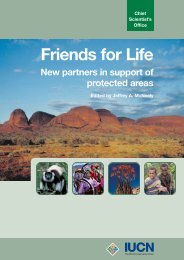Exchange programmes - IUCN
Exchange programmes - IUCN
Exchange programmes - IUCN
Create successful ePaper yourself
Turn your PDF publications into a flip-book with our unique Google optimized e-Paper software.
� the resources available to commit to the exchange;<br />
� the objectives and theme of the exchange;<br />
� the level and amount of deliverables desired from the exchange;<br />
� communication/language skills.<br />
At this stage, the planning is being done within one protected area or agency.<br />
However, once an agreement has been established (Stage 6), a joint co-operation<br />
committee composed of relevant protected area staff or managers from each partner<br />
should develop and review work plans for partnership activities, maintain communication<br />
links and periodically evaluate the programme.<br />
Assessing resource needs – both personnel and financial – will probably be considered<br />
during each of the remaining stages. Funding may suddenly disappear or (more rarely)<br />
appear, or personnel may quickly become available or unavailable: if so, co-ordinators<br />
will have to adjust their plans accordingly.<br />
Stage 2. Set clear objectives<br />
Recommendations for protected area exchanges in East Asia<br />
While the objectives of an exchange programme were probably informally discussed<br />
throughout the first stage of the planning process, once it is agreed that an exchange is<br />
desirable, it is essential to define the desired “deliverables”. The more specific one can<br />
make the statement of the need for the exchange and the goals and objectives, the more<br />
likely it is that an exchange will succeed (i.e. meet these goals and objectives).<br />
The need for the exchange – the underlying reasons or rationale as to why an exchange<br />
is felt to be necessary – should be clearly expressed as this will lead logically on to the<br />
statement of goals and objectives. The three kinds of need are set out in Section 3.1<br />
above. The statement of need can be important in terms of gaining the necessary<br />
financial and political support for the project. In particular, it may be useful to identify if<br />
there is an external threat acting as the trigger for calls for an exchange. For example, it<br />
might be felt that an exchange is needed to help address a threat to the protected area<br />
caused by a proposed new road or dam that affects the site. This can help identify<br />
constituents who should be invited to participate in, or help fund an exchange.<br />
There is a difference between goals and objectives. “Goals” are general statements of<br />
a desired end product or result, while “objectives” are more specific, measurable<br />
statements of a desired end-state. For example, a goal of an exchange programme might<br />
be to improve the managerial capacity of a specific protected area or, more specifically,<br />
to discover innovative methods of dealing with a particular issue (e.g. erosion of trails or<br />
wildlife disturbance by tourists). Examples of objectives would be “to ensure that at least<br />
80% of park visitors are satisfied with their visit”, or “to increase (or decrease) tourist<br />
visits by 20% over the next three years”. Often, a set of goals is generated, with a number<br />
of objectives relating to each goal. Being as specific as possible, even at this early stage<br />
of the process, is critical to the success of an exchange programme.<br />
Finally, even at the outset, it is important to begin thinking about how the exchange<br />
programme would be monitored and evaluated. Thinking about these essential tasks<br />
should become automatic at every stage.<br />
49






